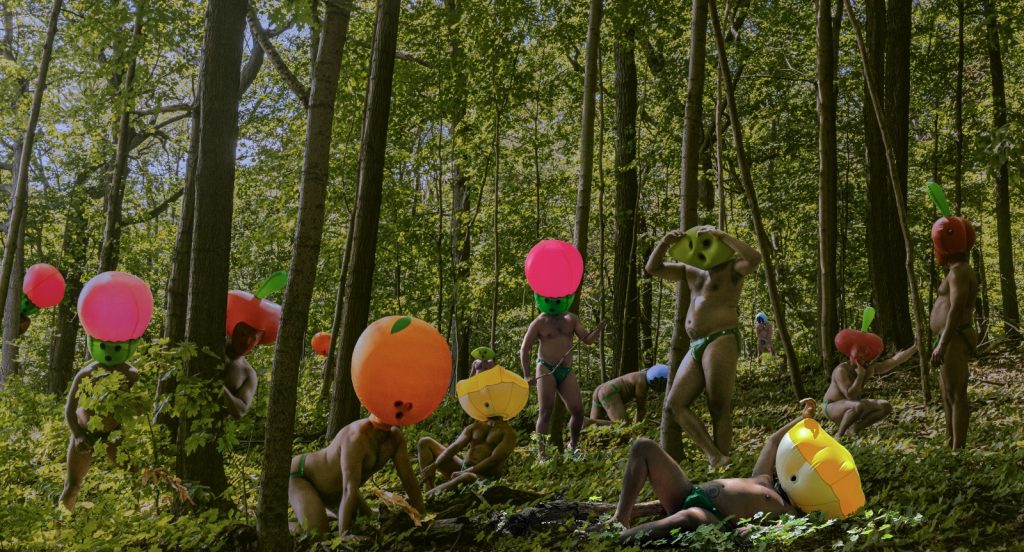
francesca ekwuyasi in conversation with Arjun Lal
On a sunny afternoon in June 2021, I meet Arjun Lal at their home studio in the north end of Halifax. Having only seen their leatherwork and performance art as Vagine—their bright eyeshadow and gold tinsel-streaked wig-wearing alter ego—I am eager to see what else they’ve been getting up to. I know of Lal’s upcoming show at the Khyber Centre for the Arts, an exhibit that will feature brightly coloured inflatable latex masks and large-scale portraits, so I’m tripping over myself to see the works-in-progress spread out on their worktable.
There are colourful swaths of latex sheets, as well as leather, ceramic, and glass pieces piquing my curiosity as we settle down to talk. I want to know everything I can about Lal and their work, so I ask them to start from the beginning.
“I’m from here,” says Lal, placing a plate of cheese, crackers, and jam on the coffee table between us. “My parents immigrated in the late 70s from India, and I was born here in 1992. I’ve always kind of done creative things like drawing and painting. I use art as an opportunity for self-reflection.”
I nod and help myself to a piece of cheese while they continue.
“For a long time, what I was making was about exploring my own mental health and trauma. It felt very personal, like a journal, something that was just for myself,” says Lal. “During high school, I started to think that maybe I wanted to pursue this [art]; it gave me joy, and I want to have joy in my life.”
“So I went to art school, and then I started thinking more about the audience. I wanted to make things for people, not just focusing on my own feelings but thinking about an audience and how art can impact them.”
Lal reflects on the power of intention—the power of creating work with purpose, profoundly personal work that reckons with tensions at the intersections of their identities. Their younger self sought healing by exploring the tension of experiencing racism and being queer and closeted. Now they’ve expanded their practice of examining these themes, with a wider lens that can hopefully reach other people.
Intrigued by the rubbery smell and brightness of the pieces on the worktable, I ask about their most recent work.
“Right now, I’m working on colourful latex masks, inflatable pieces. A couple of years ago I received a mentorship grant from Arts Nova Scotia to learn about leather and latex,” says Lal. “I was thinking a lot about fetish wear and fetish culture. “I’ve always been curious about sexuality, and that curiosity has taken me to a lot of sex-positive spaces like Berlin, New York, Toronto, and Montreal.”
But they were often struck by the overwhelming whiteness of the sex clubs and play spaces, even in these sex-positive and racially diverse cities.
“Sometimes I [would] imagine a bird’s eye view of the situation or the experience, and I started to realize everyone here is white,” says Lal. “And when I look out of my own eyes, I don’t see anyone of colour, but when other people are looking, they’re just seeing white people plus this one person of colour. And it just makes me think a lot about who those spaces are for and how I’m perceived.
“I started realizing that the demographic was very white, and the clothing that was being fetishized was all black—black leather, black latex.”
Photo documentation of fetish culture was often done in black and white as well.
“It made me feel that colour just wasn’t celebrated in fetish culture. And that as a person of colour, my body wasn’t celebrated, like colour was being perceived as an undesirable thing,” says Lal. “So that has been inspiring me to create work that intersects fetish wear, fetish visual media, and celebration of colour.”
That’s where Lal’s project has landed, a body of work called Fruits of the Forest in which they hand-make colourful inflatable latex masks influenced by fetish wear. They create, wear, and document themself in the woods, drawing inspiration from nature.
They turn their computer screen to show images of them laying, prancing, and walking in the woods wearing the fruitlike whimsical masks, surrounded by various forest greens. Some of the masks are bulbous and gem-coloured—deep reds, bright oranges, and vivid yellows that are particularly stunning in contrast to Lal’s dark brown skin. They distort the artist’s physique so that their head appears massive and only moments away from floating up into the bright blue sky.
“I just submitted this,” Lal says of one of the photos. “There’s this mural festival that puts out an open call for photos that would be printed on vinyl, eight feet by eight feet, and presented in the public space.”
The festival talked a big game about sex positivity and body positivity, which would’ve been an excellent fit for their photo documentation of Fruits of the Forest.
“I thought okay, I’m gonna go for it and live my truth. So, I submitted a nude.”
“Please tell me they said yes,” I reply, nibbling on another piece of cheese.
“Oh, well,” they shake their head no. “I asked for feedback, and they said that my write-up was very professional. And that they do other projects and they would consider me for another one.”
“Not the mural though?” I ask.
“I wish they gave better feedback regarding why not. What could I have done [differently]? But in visual media, like Hollywood, we’re used to seeing a specific body celebrated—white thin femme bodies, tall bodies, or white masculine bodies,” says Lal. “And sometimes, I feel my body isn’t represented enough. Sometimes I wonder if people would just be too uncomfortable seeing something that hasn’t been that well represented.”
Lal’s work subverts the Western media.
I consider holding my tongue but do not. I ask Lal: what if the audience is racist, sexist and transphobic? Their comfort is the least important thing. Because if we focus on comfort, we’ll just reproduce the same dominant ideas and things. That is harmful and comfortable.
Lal nods. “It’s just challenging when the ‘gatekeepers’ are driven by ticket sales or views. That’s something that I’m challenged by.”
We agree on the struggle, the tension between material reality and artistic vision, between desire and reality. On the topic of addressing this lack of representation of bodies that look like theirs, Lal has started to use their body as a medium.
“A reality for me is that the gatekeeper is like a butthole,” says Lal, “I’ve got to be slow, pragmatic, and get familiar before really pushing in.”
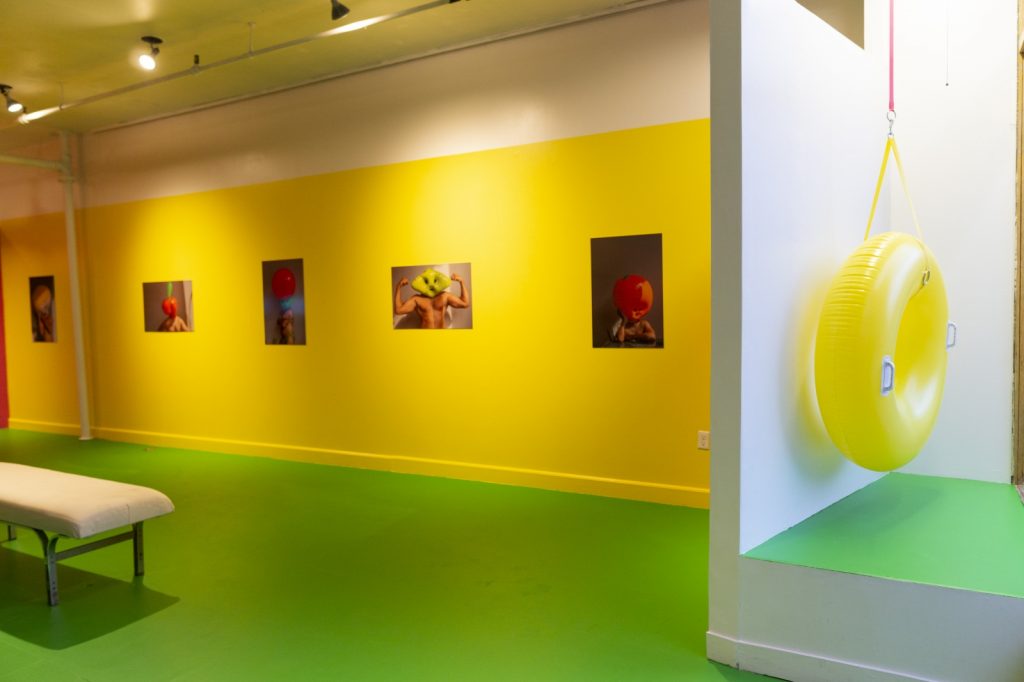
Fruits of the Forest Exhibition Review
Wren Tian-Morris 天琳琳
The first time I went to the bathhouse I had extravagant expectations, maybe a bit too grand for Halifax. I imagined colourful lights, a steamy atmosphere, decadent decor, bodies everywhere, perhaps a delicious scene going on for all to view; I was dreaming of some version of my paradise. Instead, I was met with an uninviting, utilitarian, cold, individualistic, straight-leaning, and incredibly yt (White) experience.
I mention all of this because that experience I had hoped for is kind of what I felt when stepping into Arjun Lal’s solo exhibition at the Khyber, Fruits of the Forest. Coming into the gallery on a cool fall day in October 2021, I was met with a burst of vibrant colour covering all the gallery walls and even the floor. There was a giant yellow latex innertube hanging in the window like a swing, inviting viewers to play.
Along the walls were various large-scale photographs of a brown body, Lal, dressed in inflatable latex masks and jockstraps. There was a video piece toward the end of the gallery, the innertube making its reprise here. Accompanying the prints were the latex pieces hanging on the walls, soft, colourful, round shapes, deflated and waiting to come to life again. The hanging of the latex works on the wall brings to mind many queer bedrooms that I have been in, the displaying of fetish wear and sex gear on the walls being their version of a less homo-nationalist pride flag.
Fruits of the Forest presents an alternative to the current mainstream of leather, latex, and the general BDSM fetish culture, community, and aesthetics. Before delving into this, I believe it is necessary to give some context for those less versed in queer history, so that navigating the critique of these spaces won’t get lost and seen as anti-kink.
BDSM and leather culture are historically linked to the 2SLGBTQIA+ liberation movements. Many folks from the [gay and lesbian] leather communities were some of the first to lead the way in providing awareness, care, and fundraising for 2SLGBTQIA+ people during the AIDS crisis. What folks were and are participating in is far more than a subculture; it is the fostering of community. Although these spaces are important, we must acknowledge that they often are entangled with militant aesthetics and the overbearing presence of ytness (Whiteness) that is all too comfortable assuming complicated positions of power, even if it is just through role play.
Conversations around representation can get sticky for a multitude of reasons, such as the historical and stereotypical extremes that racialized bodies are put up against concerning sex (submissive, exotified, hypersexualized, desexualized, etc.). In addition, the imagery that we are typically flooded with when it comes to traditional BDSM often evokes bondage and slave references.
Through Fruits of the Forest, Lal, a queer person of the Indian diaspora, demands not just the disruption of ytness (Whiteness) in these spaces but rather an overhaul. By inserting themself in the narrative rather than waiting for “representation” to come, they showcase the immense power of seizing autonomy over one’s image.
The whimsical use of latex interrupts the traditional narratives of BDSM while still honouring practices of service, exploration, ritual, and communication. This can be seen in more obvious forms such as Lal apprenticing under the mentorship of a leather and latex worker in Montreal. A common practice for many in the kink scene pays respect to interpersonal modes of passing on knowledge. These relationships—and kink itself—are far more than sexual intimacy, often not even including sex at all; they are much more rooted in connection and eroticism. The artist also has an intimate relationship with the materials they work with. Taking care to learn and listen to the material is a craft that requires time, patience, and precision.
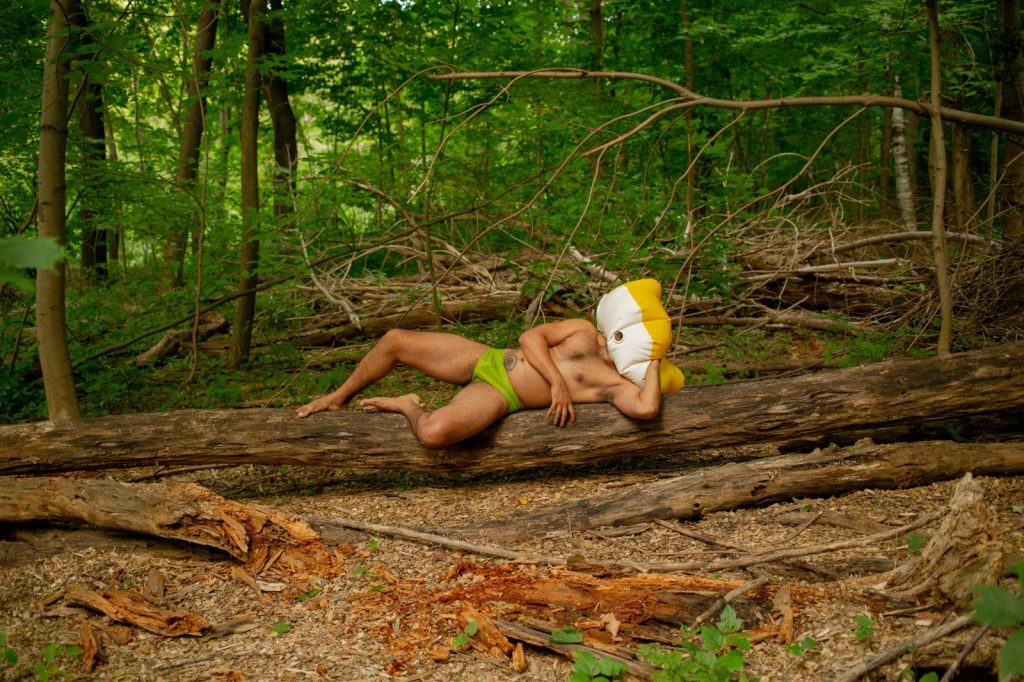
The making of these pieces becomes a ritual in itself. Lal’s fruitful creatures are found in urban and rural settings and even in some spaces completely without context (on top of cars, in the nooks of doorways, underneath a forest canopy, against a blank red background). As opposed to feelings of “primitivism” that one might observe when faced with imagery of nude brown bodies and lush greenery, we see this as a reclamation of space, an assertion of the queer brown body in all environments, as if to say, “We are everywhere, we have always been everywhere, and we will continue to be everywhere.” The chosen locations also reference cruising, the history of gay men finding secret ways of connecting due to violent and rampant surveillance and homophobia.
It is crucial that we acknowledge and respect the significant impact that the [queer and trans] BDSM and leather communities have had on current day 2SLGBTQIA+ lives. Their efforts have helped pave the way to liberation, allowing us the space to expand our imaginations beyond survival. Lal’s works in Fruits of the Forest are not inherently about rejecting the current culture but instead are a call to new possibilities. BDSM has always been about creative play; it has always been a place of radical resistance intertwined with drag queens, sex workers, trans folks, disabled queers, and anyone else rejecting cis-homonormativity.

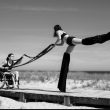
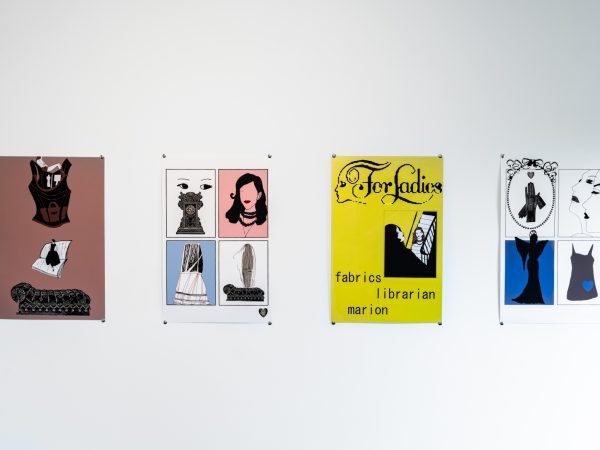
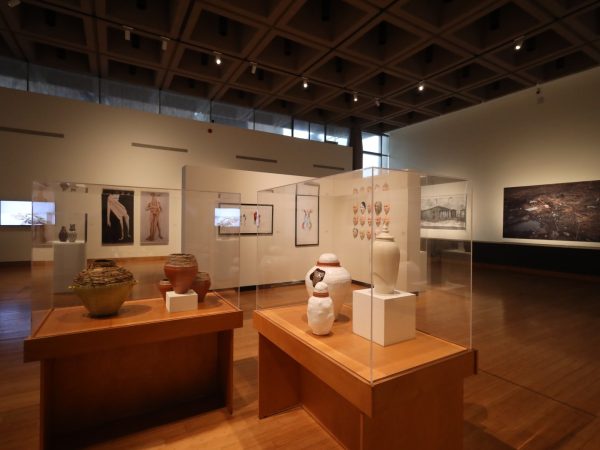











Leave a Reply